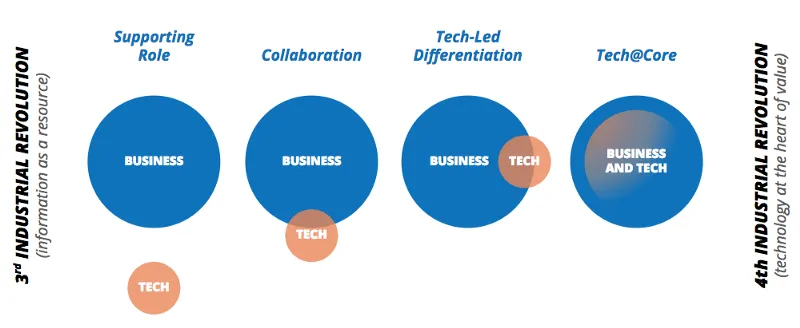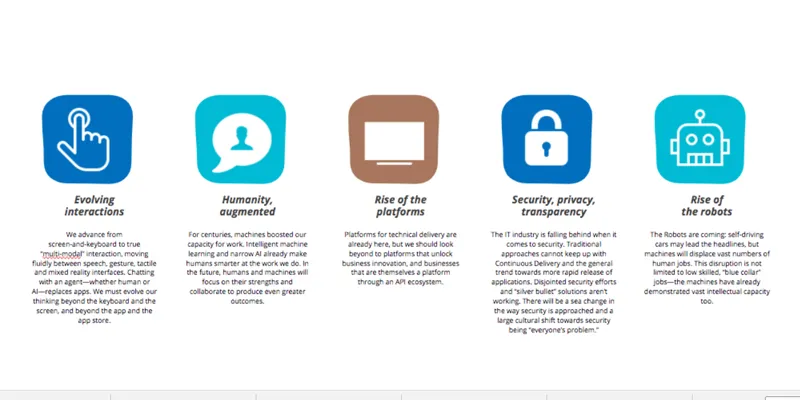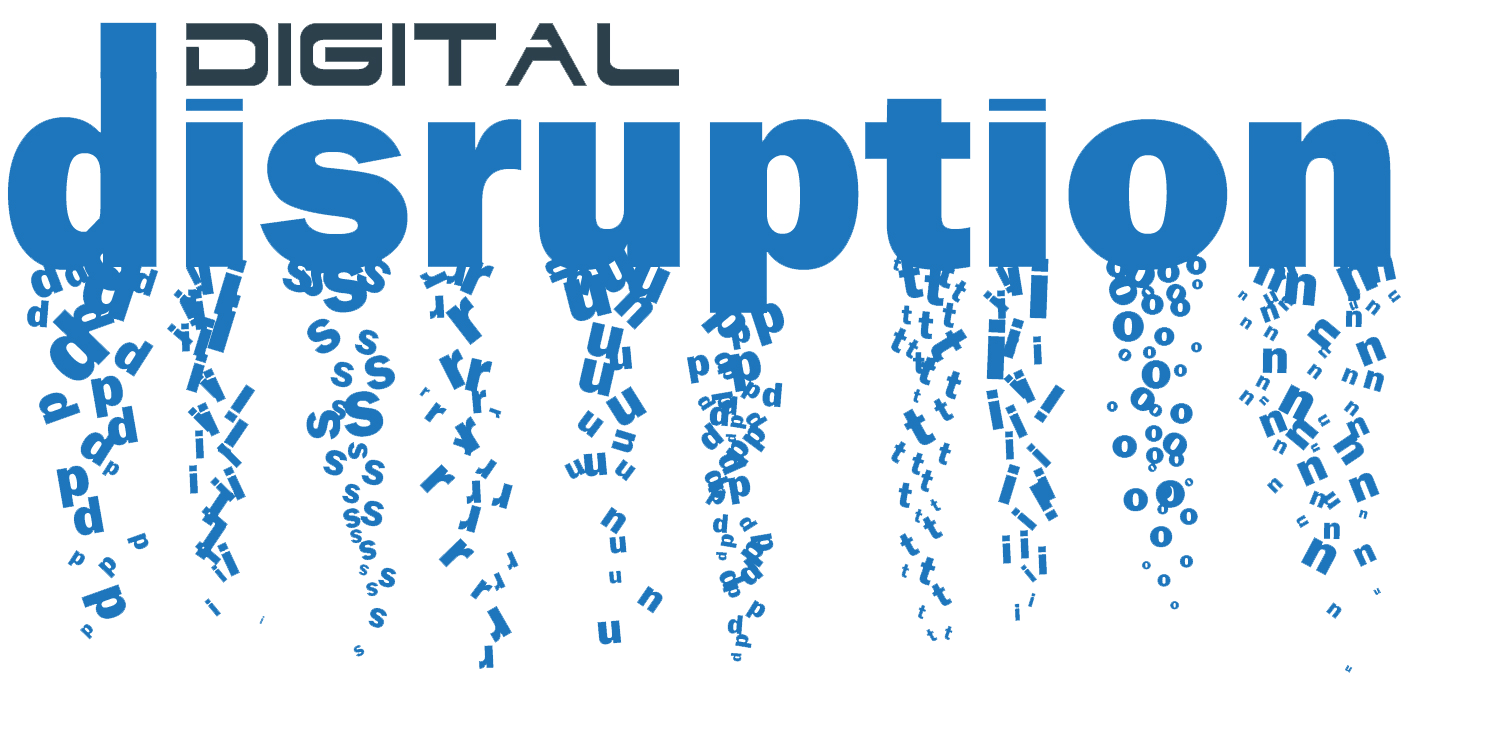Ride the disruption or be disrupted
Businesses (both startups and enterprises) are at a critical juncture. What they do over the next couple of years is going to decide their fate. Are they going to become a leader or would they be the ones going out of business and become a bygone? They are at an inflection point. Disruption is coming. And it is coming faster than ever before.
52 percent of companies in the Fortune 500 list since 2000 are gone.
Why are businesses going to be disrupted? Why is that they are going to be disrupted now or in the next couple of years? Can they insure themselves against the upcoming disruptions? How can they ride the disruption and become leaders in their space?
10 Year Disruption Cycle
Disruption is not new. Businesses have been disrupted in the past. They are getting disrupted today. And they will continue to get disrupted in the future as well. Based on the past data, disruption follows a 10-year pattern. That is, every 10 years, new mega trends take off.

Every 10 years, new businesses come riding on mega trends and disrupt existing businesses. Just the last twenty years have been phenomenally packed with change and impact.
1997–2006
This period saw the emergence of Google, Yahoo, Paypal, Amazon, eBay, etc. Towards the end of this phase saw the arrival of Facebook as well. Google started in 1997 and was launched in 1998. Yahoo, eBay, Paypal and Amazon all started around this time and flourished. The dot-com bubble was primarily driven by the over enthusiasm of capital to support this disruption.
2007–2016
The next 10 years saw the rise of new businesses. Instagram, WhatsApp, Airbnb, Uber, Dropbox, Spotify, etc. This period also saw the rise of Android and iOS. Many businesses were disrupted. Yahoo is almost dead. Where is eBay? These and many other companies were disrupted during this period. Why?
2017–2026
The current 10-year cycle has started. What new companies are we going to see? Who will get disrupted in this decade?
Technology behind disruption
All the above companies rode on mega trends. Google, Yahoo, and others rode on the trend of internet and browsers. That was the period which started the website growth and penetration. In 1995, there were less than 10,000 domains registered. By the end of 2006, there were more than 25 million domain names registered. A growth of 2500 times, in a period of 10 years. This opened the entire world of possibilities.

Google kind of organised and made the entire internet searchable in a simple and effective way. Yahoo brought the world’s news and content to people. They were called the homepage of the internet. eBay opened a platform for anyone and everyone to be able to sell their stuff online. Paypal made it really simple to pay people or businesses online, and so on. All these companies were fundamentally riding on the technology that the internet, and web browsers brought them. The key part of any mega trend is that it spurts other related innovations around them, ie, payments, e-commerce, content, etc.
The year 2007 saw the mega trends of cloud and mobile. This brought in a new way for people to interact and engage. Similar to the previous trend, this trend brought about more related innovation and new companies.
Instagram made it easy to snap and share a picture. WhatsApp made it easy to send messages to your contacts. Uber disrupted the taxi industry. Airbnb disrupted the hotel industry. Dropbox made storing on the cloud easy and affordable. This also saw the emergence of digital camera on mobile phones, leading to the death of Kodak. Here also we find a lot of related innovation alongside the mega trends; music, hotels, messaging, storage, etc.
What could be the mega trend for the next decade? AI? Data? Wearables? Robots? Crypto?

Lead, Adapt or get disrupted
As an existing business, you should plan to lead the next mega trend. Businesses which do not act upon the changes get disrupted. Yahoo was sold for a fraction of its peak value. Why? In the past decade, while cloud and mobile were the mega trends, Yahoo did little to adapt to the changing times. Similarly, Blockbuster which was a leading video rental store, went bankrupt as it failed to adapt to the cloud opportunity.
Existing companies that have flourished in this era of disruption have done so by being the leader in bringing about this disruption. Amazon introduced AWS to the world in 2006. It has been investing in cloud since 2002. It leads the cloud disruption, making it the leader. Similarly, Apple introduced iPhone and iOS in 2007, thus starting the era of mobile application.
Google invested in and acquired Android way back in 2005. Along with investing in mobile technology, Google also invested in the cloud. It launched Google Apps, its cloud offering in 2006. In stark contrast to competitors, the company not just survived the disruption, but also led the next decade of change.

Other companies survived by being fast adopters. Facebook was facing a crisis by 2010. It did not have a bet in cloud or mobile, but adapted quickly by investing heavily into mobile. Along with focusing on making the app one of the best on mobile, the company acquired WhatsApp and Instagram for an insane amount. This ensured that it led the mobile era. Similarly, Microsoft was late in the game. It lost out on the mobile os race. However, it adapted well to the cloud, opening up its suite of offerings on the cloud. It quickly followed DropBox with OneDrive and Amazon’s AWS with Azure. While it is not the leader in this space, it has managed to adapt and survive the disruption.

If businesses don’t adapt to the changing times, 10 years is a long time to go out of business. eBay and Paypal are a shadow of what they once were. eBay is closing and selling operations in different countries, while Paypal has to fight increasing competition and strive for survival. Even multi-billion dollars is not enough to help you survive. What helps is adapting to the changes.
Why is technology core of these mega trends?
By early 1970s, IT and technology started playing a supporting role for businesses. This started the third industrial revolution. Over the past 40 years, technology has moved towards collaboration, and being the leading differentiator. In the next few years, technology and business will become the core of every business. It is no wonder that most of the recent disruption were with technology at the forefront.

Why now?
Before the start of a disruption cycle, we start seeing a diversification of bets and investments going into different sectors. The investment into technological changes starts two to three years before it really takes off. Of the many number of trends or bets which start emerging, a couple of them usually find market adoption and take off. Others could either fall off or go through incremental changes over the next few years.
By 2005, there were a number of themes emerging. Clean tech was considered as one of the upcoming things to watch out for. So was nanotechnology. While they did not fizzle out completely, cloud and mobile took centerstage. Others continued to grow at a slow pace.
Similarly, between 2015 and 2017, there are many themes emerging. The strongest probably was Artificial Intelligence, and Data. We already see different use cases on these already. Autonomous vehicles, self-learning algorithms, etc. Another theme coming strong is Augmented Reality, so is Blockchain and related smart contracts. On the other side, we are beginning to see more advanced robots.
In such a chaotic environment, how to make sense and simply absorb all these?
The Disruption Landscape
It is not uncommon to hear about a new trend every week, which could possibly disrupt your industry. It is easy to be overwhelmed by all this news. The more you hear, the more anxious and even confused one gets. Hence it is important to map these technology trends, in a way that it makes it easy to understand them.
The below matrix maps all that is happening in the world in an easy to understand and digest format.

This framework could be used by anyone to keep track of what’s going on in their industry. On one side, it is about mapping trends which they are seeing quite frequently. The second column is about the trends which are beginning to catch fancy and grow. Third and the last column is about trends far away on the horizon.
Similarly, each of these trends can then be mapped to the different level of impact. Some trends would need an immediate action plan. Some would need to begin experiments. While other trends might need to build perspective, knowledge, and research at this moment.
This is a sample and across different trends. You should be able to build one for yourself and your company to track, have discussions around them and keep evaluating different mega trends from time to time.
Seismic Shifts
At ThoughtWorks, my employer, we have come with a yearly release of mega trends and technology themes to watch out for. We call it Seismic Shifts, and quite aptly so.

There is a lot of work which needs to be done if you have not started taking steps already. From mapping to understanding to investing to researching to experimenting to implementing to adapting to leading new technology trends.
We are already seeing lines getting blurred between virtual and real. There are camera applications like BeautyPlus, which are combining AI and VR to give an immersive experience. People can take selfies and then apply makeup, props or enhancements to make their pictures look great.
Similarly, we have got Alexa from Amazon, Siri from Apple or Home from Google which takes speech as an input. These devices are doing away the need for keyboards. On the other front, Tesla is bringing cars on the street which can drive by themselves. These cars detect obstructions, lanes and road signs using a mix of computer vision, and machine learning.
All the while, the driver can just sit back and relax, or attend a meeting over a video call. We are already having 4G technology which aids in making these video calls. The 5G technology is almost here. The next generation may not see the word ‘buffering’.
What’s new happening in the e-commerce or retail industry? How will the traditionally non-digital companies use these technologies? What about media and entertainment? Will technology finally come in aid of the poor and help solve their problems? Will IoT and wearables see major adoption in the coming decade?
Conclusion
Most of these technologies are in their infancy. They are going to get mature over the next couple of years. As they get there, the adoption would skyrocket bringing in an era of new companies.
The disruptors of the yesteryears could get disrupted in the coming years. Wait and watch as a strategy may not work this time. With newer technologies, the time to adapt is getting shorter. Businesses today may not have the time their predecessors had. There is a high probability of an unknown startup disrupting them or bringing a new offering in their space.
Note for large enterprises: There is an immediate need to start looking at new mega trends and get started on the process. This is not only important for businesses who want to lead, but also businesses who want to survive the next 10 years.
Large companies should invest into newer technologies, set up in innovation labs, and roll out experiments alongside doing business as usual. They should invest in the future, either directly or via acquisitions. And the sooner it is, the better.
Which of these numerous technology trends would become mainstream is a question which can only be answered with time. Albeit, we can see what some major players, investors and startups are leaning towards. Apple, Google and a dozen other companies are investing into autonomous cars. Amazon, Google, and Apple are investing into voice based interaction.
At the same time, Facebook and Microsoft are investing in virtual reality with oculus and hololens. Facebook has launched their messenger bot platform a couple years back. Investors are putting money in cryptocurrency and blockchain. Lot of startups are working on newer ways of managing cryptocurrency and introducing new ones. These and others could serve as an indicator of what could happen in the future. That said, it is highly likely, something new will be introduced in the next couple of years, and could take centerstage and become a mega trend.
Irrespective whether businesses lead, adapt or get disrupted, the next couple of years are going to be very interesting.











